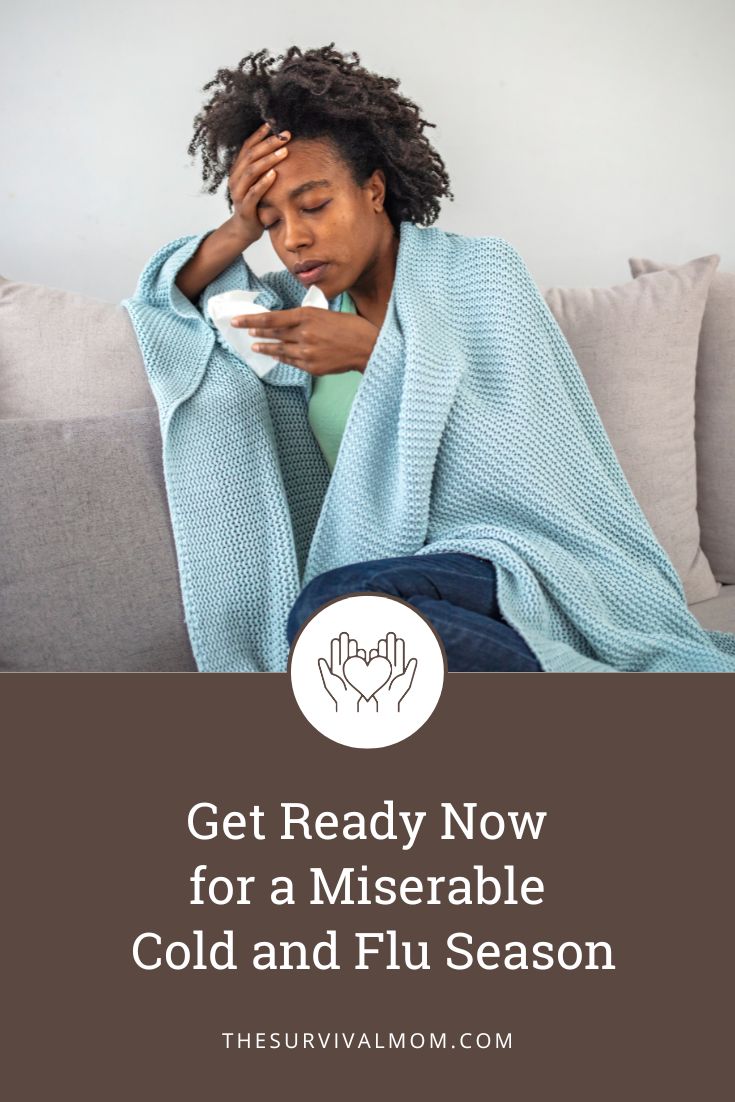Some of the links in this post may contain affiliate links for your convenience. As an Amazon associate I earn from qualifying purchases.
I never get sick. I have a killer immune system. Usually, the cold and flu season passes me by, but this time, I wasn’t so fortunate. With no flu survival plan in place, the flu hit me hard. I was knocked off my feet for more than two weeks.
At one point, my fever was high enough that I was delirious and giving my husband crazy instructions for plugging in a heating pad as my whole body was wracked with violent shivering.
What was funny is that I knew what I was saying made no sense, I knew I was delirious, and I still kept talking crazy talk. Thank God my husband has a good sense of humor!

When is the cold and flu season?
Seasonal influenza (flu) viruses occur year-round; however, in the U.S., there is usually an increase in activity during the fall and winter.
When is the peak of flu season?
According to the Centers for Disease Control (CDC), flu cases typically peak between December and February.
Centers for Disease Control Flu Map
This CDC flu map charts weekly influenza activity across the nation. If you’re wondering if there is flu going around right now in your area, you can check the map.
Here is a download for the week ending November 5, 2022. You can see that right now, the southeast is getting hit the hardest.

Is it a cold or the flu?
I knew I had a case of the flu when my symptoms became very extreme very quickly. However, for some people, symptoms of the cold can be confused with those of the flu.
It’s easy to confuse symptoms of the common cold with the flu, but in general, flu symptoms are simply worse. The flu comes with a fever, severe body aches, a deep cough, violent chills, and severe fatigue — truly miserable symptoms.
A cold isn’t a whole lot of fun, either, but those symptoms are milder — runny nose, sore throat, plenty of sneezing, body aches, and mild fatigue. Once symptoms cross the line from feeling “under the weather” to “just kill me now,” you probably have the flu.
Put Together a Flu and Cold survival Kit
Before you’re faced with a sick family and have no choice but to make a mad dash to the drugstore, you’ll want to stock up on medicine for cold and flu and a few other items to make the best of sick days.
Trust me on this.
One year, the flu completely blindsided me. I’d read the headlines declaring a near-epidemic in some parts of the country but noted that my state, Arizona, hadn’t been hit particularly hard. So when my son had a short bout with what I thought was a 24-hour stomach bug, I wasn’t worried.
Three days later, he was nearly catatonic with a fever and a deep, racking cough. My brain hadn’t been thinking “flu,” so my husband and I were running to the store for ginger ale, extra Kleenex, and a new thermometer.
In hindsight, I really shouldn’t have been so complacent. Although we rarely get sick, it would have been so simple to put together a kit filled with items to help us get through the worst of any sickness. After all, if mom and dad were ever sidelined by an illness, my kids were too young to drive to the store!
My goal is to keep everything in one place so we aren’t running around trying to locate a stray thermometer or the jar of honey that’s somewhere in the pantry. I also want the kids to know where this box is located and what each item is for.
Here’s what I assembled in our box so we’re ready when the flu bug bites again.
- Lozenges
- Vitamin C (chewable for kids)
- A heating pad
- Large, unopened box of tissues
- Small bottle each of NyQuil and DayQuil. Your choices may be different.
- Small bottle of crystallized ginger for homemade ginger tea. You can also put a couple of crystals inside your cheek and allow them to dissolve slowly. Crystallized ginger doesn’t have as strong a bite as fresh.
- Unopened bottle of ginger ale for nausea.
- A small, unopened jar of honey for coughs. (Not for use with babies, though.)
- Unopened bottle of hand sanitizer
- Thermometer with disposable probe covers
- Small bottle of ibuprofen and/or acetaminophen
- Anti-diarrheal medicine — Ask your doctor or pharmacist for a recommended brand.
- Emesis/vomit bags — Better to use than a bowl or toilet to prevent splashing. Ugh.
- A few pairs of disposable gloves
- Face masks to keep contagion to the minimum when tending to the sick person
- My favorite essential oil diffuser and a few oils that are beneficial, such as eucalyptus, Raven (a Young Living blend), frankincense, and lavender (for a good night’s sleep). I even have a diffuser for my car and just LOVE it!
I thought of adding a box of saltines, but these go horrifically bad after a couple of months due to the small amount of oil in the crackers. A sealed box of pilot bread would stay fresh, though.
Also, I’ve also found that sippy cups (yes, even for older kids and adults) are helpful for always having liquids at hand while avoiding all-too-frequent spills. A case of Gatorade or Pedialyte provides fluids, along with electrolytes potassium, magnesium, and sodium. A homemade version is simple to make, too.
Recipe for DIY Rehydration Fluid
A simple DIY rehydration concoction you can easily mix up in your own kitchen is another good addition. A few months ago, I assembled forty of these packets and have tucked them into my pantry, vehicle Emergency kit, and have even put a few in the glove compartment of my husband’s truck.
Here’s the basic recipe:
Yup, that’s it. Some people add a bit of Kool-Aid to provide flavor, but it isn’t necessary. When this sugar/salt combo is mixed with a liter of clean water, you have an effective rehydration fluid that will go a long way toward helping someone recover from a bout with the stomach flu.
Set Up a Sick Room
Once a family member has been diagnosed with a case of the flu, in particular, it’s time to set up a “sick room” with all these supplies handy.
On the bedside table, have facial tissue, a spill-proof cup filled with water, Gatorade, or something similar, and a trash can to hold used tissues. A high fever will require extra blankets, a heating pad, or a hot water bottle, so have those handy as well.
Limit the amount of time well family members spend in the sick room. If there’s anything worse than a full-blown case of the flu, it’s everyone in the family sick with the flu!
If the flu includes nausea, have ready a bucket for vomit, extra towels, and disinfecting wipes to clean all the surfaces that may have been on the receiving end of any splatter. (Ugh — I know, but when you have a home with kids, this is what you deal with!)
How to Minimize Spread
You’ll certainly want to limit this cold or flu to the poor victim who is down for the count. To stop the virus from spreading, family members must wash their hands frequently. To help the kids remember, create a checklist and have them record with a sticker or a check mark every time they wash their hands during the day.
Make sure everyone knows how to sneeze properly, covering their sneeze with either a tissue or sneezing into the inside of their elbow. And, when you leave the sick room, be sure to wash your own hands with soap and water.
survival plan infographic” width=”600″ height=”1500″ srcset=”https://thesurvivalmom.com/wp-content/uploads/2022/11/Flu-survival-Plan-Infographic-scaled.jpg 600w, https://thesurvivalmom.com/wp-content/uploads/2022/11/Flu-survival-Plan-Infographic-160×400.jpg 160w, https://thesurvivalmom.com/wp-content/uploads/2022/11/Flu-survival-Plan-Infographic-451×1128.jpg 451w, https://thesurvivalmom.com/wp-content/uploads/2022/11/Flu-survival-Plan-Infographic-768×1920.jpg 768w, https://thesurvivalmom.com/wp-content/uploads/2022/11/Flu-survival-Plan-Infographic-614×1536.jpg 614w” data-lazy-sizes=”(max-width: 600px) 100vw, 600px” src=”https://thesurvivalmom.com/wp-content/uploads/2022/11/Flu-survival-Plan-Infographic-scaled.jpg”/>
Three Natural Remedies for the Cold and Flu Season
In addition to over-the-counter cold and flu medicine, natural remedies can also be effective against the miserable symptoms of the flu and colds. We use a lot of essential oils in our home, with eucalyptus, lavender, and frankincense. These are all good choices for a flu patient’s sick room.
The following three recipes use natural ingredients that can be found in the healthy living section of grocery stores, in health food stores, and on Amazon. These can be made ahead of time and then stored at room temperature or in the refrigerator until needed.
Homemade Aromatic Chest Rub
- 1 oz. coconut oil
- 1 oz. olive oil
- 6 drops of tea tree essential oil
- 4 drops of eucalyptus essential oil
- 4 drops of lavender essential oil
Warm the coconut oil until liquid. Combine all ingredients. Let sit at room temperature or in the refrigerator until solidified.
Essential Oil Vapor Rub
- 10 drops eucalyptus essential oil
- 10 drops peppermint essential oil
- 3 drops thyme essential oil
- 1/8 c. olive oil
Combine all the oils and mix well. To use, rub the oil mixture over the throat and chest, then cover up to help increase the warming effect. This is very effective when done right at bedtime as it helps relieve congestion and helps you fall asleep more easily.
Herbal Congestion Rub
This recipe takes a couple of days to make and then another few days to allow the ingredients to settle in and “marry.”
- 1/2 c. dried lavender (antiseptic healing, topically healing, pain relieving)
- 1/4 c. dried mullein leaves (helps break up congestion)
- 1/4 c. dried peppermint (cooling and provides pain relief)
- 1/4 c. fresh grated ginger (breaks up congestion)
- 3/4 c. coconut oil
- 3/4 c. olive oil
- 3 T. beeswax pellets
- First, combine the essential oils in a small crock pot and then mix in all the herbs.
- Cook on Low for two days.
- Prepare to filter the herbal mixture by placing a piece of cheesecloth in a mesh colander.
- Pour the hot mixture into the colander and allow time for it to filter through, leaving the herbs behind.
- Pour the filtered oil back into the crock pot and add the beeswax pellets, a few at a time, until the wax is all melted and the mixture is smooth.
- Pour the rub into small jars, cap tightly, and store in a cool, dark location.
Learn about other home remedies used during the Great Depression here. These can complement a traditional approach.
The Final Word
The time to prepare for the cold and flu season is now. You’ll thank yourself later if your family members start to fall like dominoes as the virus makes its rounds through your house. Educate everyone on what to do and how to use the items, so if you’re out of commission, they can take care of themselves AND you.
How do you prepare your home and family for a case of the flu or cold?
Originally published December 8, 2017; updated by The survival Mom editors.
I’m the original survival Mom and for more than 11 years, I’ve been helping moms worry less and enjoy their homes and families more with my commonsense prepping advice.
survival-plan/”>Source link

